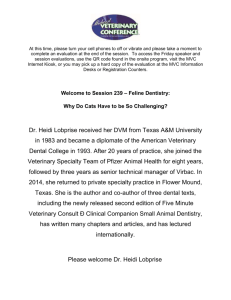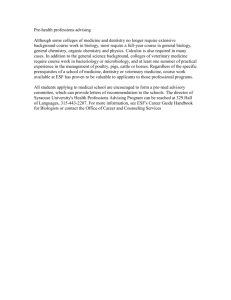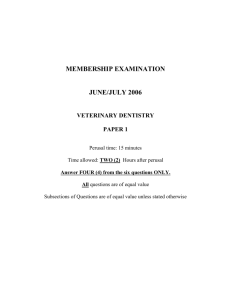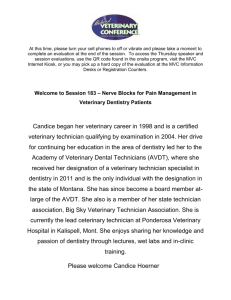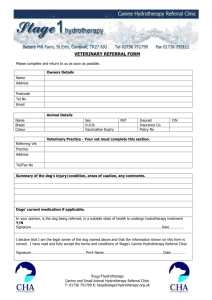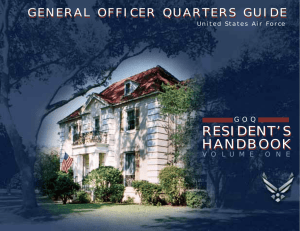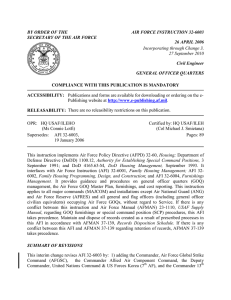Dentistry
advertisement
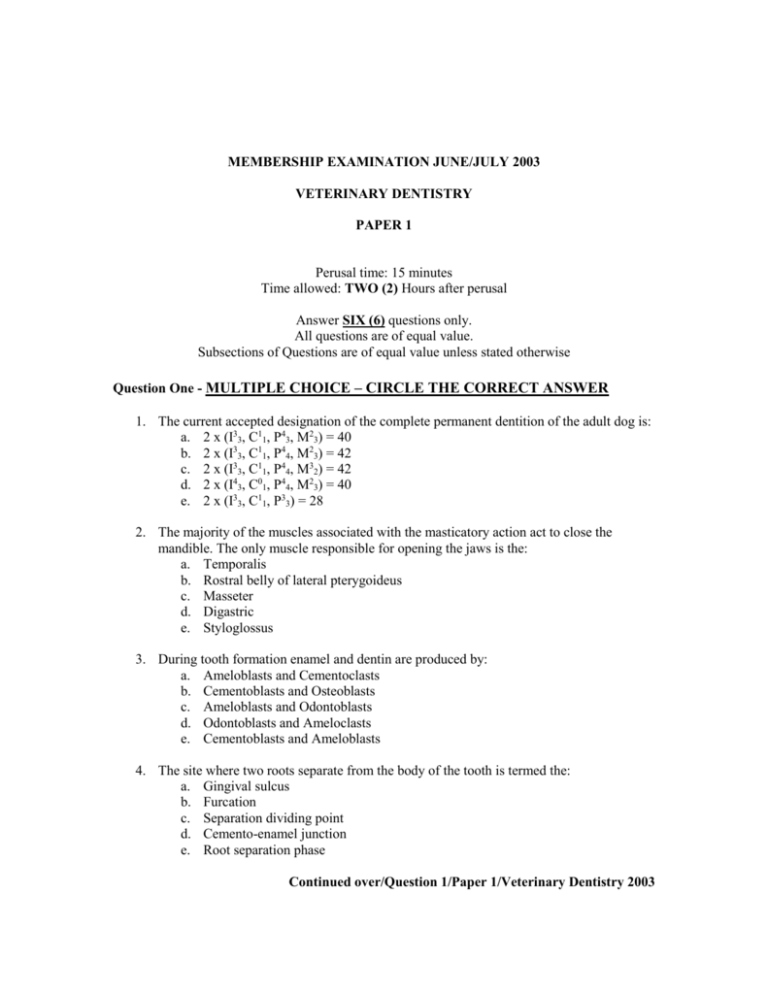
MEMBERSHIP EXAMINATION JUNE/JULY 2003 VETERINARY DENTISTRY PAPER 1 Perusal time: 15 minutes Time allowed: TWO (2) Hours after perusal Answer SIX (6) questions only. All questions are of equal value. Subsections of Questions are of equal value unless stated otherwise Question One - MULTIPLE CHOICE – CIRCLE THE CORRECT ANSWER 1. The current accepted designation of the complete permanent dentition of the adult dog is: a. 2 x (I33, C11, P43, M23) = 40 b. 2 x (I33, C11, P44, M23) = 42 c. 2 x (I33, C11, P44, M32) = 42 d. 2 x (I43, C01, P44, M23) = 40 e. 2 x (I33, C11, P33) = 28 2. The majority of the muscles associated with the masticatory action act to close the mandible. The only muscle responsible for opening the jaws is the: a. Temporalis b. Rostral belly of lateral pterygoideus c. Masseter d. Digastric e. Styloglossus 3. During tooth formation enamel and dentin are produced by: a. Ameloblasts and Cementoclasts b. Cementoblasts and Osteoblasts c. Ameloblasts and Odontoblasts d. Odontoblasts and Ameloclasts e. Cementoblasts and Ameloblasts 4. The site where two roots separate from the body of the tooth is termed the: a. Gingival sulcus b. Furcation c. Separation dividing point d. Cemento-enamel junction e. Root separation phase Continued over/Question 1/Paper 1/Veterinary Dentistry 2003 Continued/Question 1/Paper 1/Veterinary Dentistry 2003 5. Oral eosinophilic granuloma complex in dogs is most commonly occurs in the following breed: a. German Shepherd b. Great Dane c. Giant Schnauzer d. Siberian Husky e. Miniature Poodle 6. Dental radiographic film speeds are defined as: a. 1, 2, 3, 4, 5, 6 b. 0, ½, 1, 2, 4, 8 c. A, B, C, D, E, F d. A, B, C, 1, 2, 3 e. ά, β, γ, δ, ε, λ 7. An endodontic file with a black handle would be sized: a. 35, 70, 130 b. 40, 80, 140 c. 10, 20, 30 d. 40, 90, 130 e. 40, 80, 130 8. A Hedstroem endodontic file should be used in a _______ motion: a. Push-pull b. Push, twist 90 degrees and pull c. Pull, twist 90 degrees and push d. Rotate through 360 degrees while maintaining firm pressure against the dentinal wall e. Rock and roll 9. The current accepted designation of the complete permanent dentition of the adult wombat is: a. 2 x (I11, P11, M44) = 24 b. 2 x (I11, P11, M44) = 28 c. 2 x (I22, P11, M33) = 24 d. 2 x (I22, C11, P22, M33) = 32 a. 2 x (I33, P22, M33) = 32 10. In the horse, the number of infundibulum in the mandibular teeth is/are: a. 4 b. 3 c. 2 d. 1 e. 0 Continued over/1/Paper 1/Veterinary Dentistry 2003 Continued /Paper 1/Veterinary Dentistry 2003 Question Two. MULTIPLE CHOICE – CIRCLE THE CORRECT ANSWER 1. The current accepted designation of the complete deciduous dentition of the cat is: e. 2 x (I33, C11, P32, M11) = 30 f. 2 x (I33, C11, P23, M11) = 30 g. 2 x (I33, C11, P22) = 24 h. 2 x (I33, C11, P32) = 26 i. 2 x (I33, C11, P23) = 26 2. The incisor teeth of the cat and rabbit respectively are classified: a. Radicular hypsodont and brachyodont b. Aradicular hypsodont and brachyodont c. Brachyodont and brachyodont d. Brachyodont and radicular hypsodont e. Brachyodont and aradicular hypsodont 3. The material of choice to line a cavity preparation when the pulp is exposed or near to exposed is: a. Calcium hydroxide b. Zinc phosphate c. Polycarboxylate cements d. Non-zinc amalgam e. Bisphenol A-glycidyl methacrylate composite resins 4. The antibiotic metronidazole, has activity against: a. Anaerobic bacteria b. Aerobic bacteria c. Both anaerobic and aerobic bacteria d. Aerobic bacteria and viruses e. Viruses only 5. The most common oral tumour in cats is: a. Malignant melanoma b. Squamous cell carcinoma c. Fibrosarcoma d. Haemangiosarcoma e. Osteosarcoma 6. The five common intraoral dental film sizes are: a. A, B, C, D, E b. 1, 2, 3, 4, 5 c. VS, S, I, U, E d. 0, 1, 2, 3, 4 e. A, E, I, O, U Continued over/Question 2/Paper 1/Veterinary Dentistry 2003 Continued/Question 2/Paper 1/Veterinary Dentistry 2003 7. A resorptive lesion on the labial surface of a maxillary canine tooth adjacent to the gingival margin in a cat is classified as a class: a. I b. II c. III d. IV e. V 8. The type of orthodontic movement that is used to move a base narrow canine tooth using an incline plane is: a. Tipping b. Extrusion c. Rotation d. Translocation e. Pushing 9. The final tooth to erupt in the permanent dentition of the horse is the: a. 3rd incisor b. Canine c. 2nd premolar d. 4th premolar e. 3rd molar 10. The current accepted designation of the complete permanent dentition of the adult kangaroo is: a. 2 x (I31, C0-11, P33, M44) = 34-36 b. 2 x (I31, C0-11, P44, M33) = 34-36 c. 2 x (I31, C0-11, P22, M44) = 32-34 d. 2 x (I31, C0-11, P44, M22) = 32-34 e. 2 x (I31, C0-11, P33, M33) = 32-34 Question Three. Discuss the indications for the use of antibiotics in diseases or conditions of the oral cavity and the rationale for their use. Question Four. Describe the design, use and function of FIVE (5) of the following: 1. 2. 3. 4. 5. 6. 7. 8. Periodontal probe Curved scaler Gracey curette Conical sharpening stone Amalgam carrier Howe pliers Dental luxator Magnetostrictive ultrasonic scaler Continued over/Paper 1/Veterinary Dentistry 2003 Continued/Paper 1/Veterinary Dentistry 2003 Question Five. Discuss the factors that contribute to the development of periodontal disease in the dog. Question Six. Review the anatomy of the salivary glands, the composition and function of saliva in the cat. Question Seven. Describe the principles and techniques required in obtaining a good quality radiograph of: 1. the upper fourth premolar tooth in a cat, AND 2. the lower first molar tooth in a dog Question Eight. Discuss the important anatomical structures of the oral cavity with relation to extraction of the maxillary fourth premolar tooth in the dog. END OF PAPER MEMBERSHIP EXAMINATION JUNE/JULY 2003 VETERINARY DENTISTRY PAPER 2 Perusal time: 15 minutes Time allowed: TWO (2) Hours after perusal Answer SIX (6) questions only. All questions are of equal value. Subsections of Questions are of equal value unless stated otherwise Question One Refer to the attached dental chart for the four-year-old female domestic short hair breed cat. Discuss the steps involved in a professional dental treatment (dental prophylaxis and periodontal treatment). How would your treatments and homecare plan differ for a client that was willing to do ‘whatever it takes’ compared to one that was willing to do ‘nothing’ post treatment with respect to oral health and plaque accumulation? Question Two You are about to expand and upgrade your veterinary dentistry services in your practice. How would you market this to your staff and your clients? Question Three Discuss the principles of exodontia. Describe how you would extract a mandibular canine tooth with a healthy periodontium in a 12 month-old dog. Compare this to extracting a maxillary fourth premolar with a resorptive lesion on the distal cusp in a 12-year-old cat. Question Four A 13 year old female Siamese cat presents with anorexia. Her diet consists of a commercial canned pet food, she is fully vaccinated and has been an indoor cat her whole life. She has received no dental homecare or professional treatments during her life. On oral examination you notice she has moderate dental plaque and dental calculus build-up on a number of teeth, severe gingivitis as well as several absent teeth. Haematology has been performed and systemic disease has been ruled out. Discuss possible oral causes for her anorexia and how you would diagnose and treat them. Question Five An 18 month old Corgi breed dog presents with a history of trauma involving the maxillary left canine tooth. The dog’s tooth received a blow from a golf club, which has removed the coronal third of the tooth resulting in pulp tissue exposure of approximately 36 hours duration. Discuss your proposed endodontic management of this case, including treatment options available to the owner, and how you would perform the procedure(s) proposed. Continued over/Paper 2/Veterinary Dentistry/2003 Continued/Paper 2/Veterinary Dentistry/2003 Question Six Your receptionist has just received a telephone call from a distraught Great Dane breeder stating that her best show dog, a six year-old male Australian Champion, has just avulsed his lower left third incisor tooth. The owner wishes to save the tooth and prolong the dog’s show career. Discuss your telephone protocol for this owner prior to bringing the dog and tooth into the practice, as well as your proposed management of this case, including treatment options available to the owner, and how you would perform the procedure(s) performed. Question Seven An eleven month-old female Staffordshire bull terrier breed dog presents to your clinic with halitosis and bilateral lingually deviated mandibular canine teeth. The owner would like to show the dog but is concerned about its appearance, as well as the hard palate ulcers resulting from trauma from the teeth. There is a normal diastema between the maxillary third incisor and canine teeth bilaterally. Describe the orthodontic treatment options available, how you would perform them and any future complications that may arise from your choices. Question Eight A four year-old thoroughbred horse presents with a ventral swelling of the left mandible. Discuss your approach to diagnosis, differential diagnosis and treatment options available for each of your diagnoses. END OF PAPER
